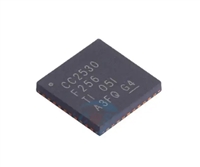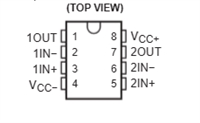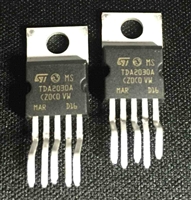InnoSwitch3-CP
The most likely event that could require an additional handshake is
when the primary stops switching as the result of a momentary line
brown-out event. When the primary resumes operation, it will default
to a start-up condition and attempt to detect handshake pulses from
the secondary.
is in order to ensure that there is sufficient reset time after primary
conduction to deliver energy to the load.
Maximum Switching Frequency
The maximum switch-request frequency of the secondary controller
is fSREQ
.
If the secondary does not detect that the primary responds to switching
requests for 8 consecutive cycles, or if the secondary detects that the
primary is switching without cycle requests for 4 or more consecutive
cycles, the secondary controller will initiate a second handshake
sequence. This provides additional protection against cross-conduction
of the SR FET while the primary is switching. This protection mode
also prevents an output overvoltage condition in the event that the
primary is reset while the secondary is still in control.
Frequency Soft-Start
At start-up the primary controller is limited to a maximum switching
frequency of fSW and 75% of the maximum programmed current limit
at the switch-request frequency of 100 kHz.
The secondary controller temporarily inhibits the FEEDBACK short
protection threshold (VFB(OFF)) until the end of the soft-start (tSS(RAMP)
time. After hand-shake is completed the secondary controller linearly
ramps up the switching frequency from fSW to fSREQ over the tSS(RAMP)
time period.
)
Wait and Listen
When the primary resumes switching after initial power-up recovery
from an input line voltage fault (UV or OV) or an auto-restart event, it
will assume control and require a successful handshake to relinquish
control to the secondary controller.
In the event of a short-circuit or overload at start-up, the device will
move directly into CC (constant-current) mode. The device will go
into auto-restart (AR), if the output voltage does not rise above the
VFB(AR) threshold before the expiration of the soft-start timer (tSS(RAMP)
after handshake has occurred.
)
As an additional safety measure the primary will pause for an
auto-restart on-time period, tAR (~82 ms), before switching. During
this “wait” time, the primary will “listen” for secondary requests. If it
sees two consecutive secondary requests, separated by ~30 ms, the
primary will infer secondary control and begin switching in slave
mode. If no pulses occurs during the tAR “wait” period, the primary
will begin switching under primary control until handshake pulses are
received.
The secondary controller enables the FEEDBACK pin-short protection
mode (VFB(OFF)) at the end of the tSS(RAMP) time period. If the output
short maintains the FEEDBACK pin below the short-circuit threshold,
the secondary will stop requesting pulses triggering an auto-restart
cycle.
If the output voltage reaches regulation within the tSS(RAMP) time
period, the frequency ramp is immediately aborted and the secondary
controller is permitted to go full frequency. This will allow the
controller to maintain regulation in the event of a sudden transient
loading soon after regulation is achieved. The frequency ramp will
only be aborted if quasi-resonant-detection programming has already
occurred.
Audible Noise Reduction Engine
The InnoSwitch3-CP features an active audible noise reduction mode
whereby the controller (via a “frequency skipping” mode of operation)
avoids the resonant band (where the mechanical structure of the
power supply is most likely to resonate − increasing noise amplitude)
between 7 kHz and 12 kHz - 143 ms and 83 ms. If a secondary
controller switch request occurs within this time window from the last
conduction cycle, the gate drive to the power MOSFET is inhibited.
Maximum Secondary Inhibit Period
Secondary requests to initiate primary switching are inhibited to
maintain operation below maximum frequency and ensure minimum
off-time. Besides these constraints, secondary-cycle requests are
also inhibited during the “ON” time cycle of the primary switch (time
between the cycle request and detection of FORWARD pin falling
edge). The maximum time-out in the event that a FORWARD pin
falling edge is not detected after a cycle requested is ~30 ms.
Secondary Controller
As shown in the block diagram in Figure 5, the IC is powered by a
4.4 V (VBPS) regulator which is supplied by either VOUT or FWD. The
SECONDARY BYPASS pin is connected to an external decoupling
capacitor and fed internally from the regulator block.
The FORWARD pin also connects to the negative edge detection
block used for both handshaking and timing to turn on the SR FET
connected to the SYNCHRONOUS RECTIFIER DRIVE pin. The
FORWARD pin voltage is used to determine when to turn off the
SR FET in discontinuous conduction mode operation. This is when
the voltage across the RDS(ON) of the SR FET drops below zero volts.
Output Voltage Protection
In the event that the sensed voltage on the FEEDBACK pin is 2%
higher than the regulation threshold, a bleed current of ~2.5 mA (3
mA max) is applied on the OUTPUT VOLTAGE pin (weak bleed). This
bleed current increases to ~200 mA (strong bleed) in the event that
the FEEDBACK pin voltage is raised beyond ~10% of the internal
FEEDBACK pin reference voltage. The current sink on the OUTPUT
VOLTAGE pin is intended to discharge the output voltage after
momentary overshoot events. The secondary does not relinquish
control to the primary during this mode of operation.
In continuous conduction mode (CCM) the SR FET is turned off when
the feedback pulse is sent to the primary to demand the next
switching cycle, providing excellent synchronous operation, free of
any overlap for the FET turn-off.
If the voltage on the FEEDBACK pin is sensed to be 20% higher than
the regulation threshold, a command is sent to the primary to either
latch-off or begin an auto-restart sequence (see Secondary Fault
Response in Feature Code Addendum). This integrated VOUT OVP can
be used independently from the primary sensed OVP or in conjunction.
The mid-point of an external resistor divider network between the
OUTPUT VOLTAGE and SECONDARY GROUND pins is tied to the
FEEDBACK pin to regulate the output voltage. The internal voltage
comparator reference voltage is VFB (1.265 V).
The external current sense resistor connected between ISENSE and
SECONDARY GROUND pins is used to regulate the output current in
constant current regulation mode.
FEEDBACK Pin Short Detection
If the sensed FEEDBACK pin voltage is below VFB(OFF) at start-up, the
secondary controller will complete the handshake to take control of
the primary complete tSS(RAMP) and will stop requesting cycles to initiate
auto-restart (no cycle requests made to primary for longer than tAR(SK)
second triggers auto-restart).
Minimum Off-Time
The secondary controller initiates a cycle request using the inductive-
connection to the primary. The maximum frequency of secondary-
cycle requests is limited by a minimum cycle off-time of tOFF(MIN). This
6
Rev. D 08/18
www.power.com






 CC2530无线微控制器:资料手册参数分析
CC2530无线微控制器:资料手册参数分析

 NE5532双低噪声运算放大器:资料手册参数分析
NE5532双低噪声运算放大器:资料手册参数分析

 74LS138 3-to-8线解码器/多路复用器:资料手册参数分析
74LS138 3-to-8线解码器/多路复用器:资料手册参数分析

 TDA2030音频功率放大器:资料手册参数分析
TDA2030音频功率放大器:资料手册参数分析
